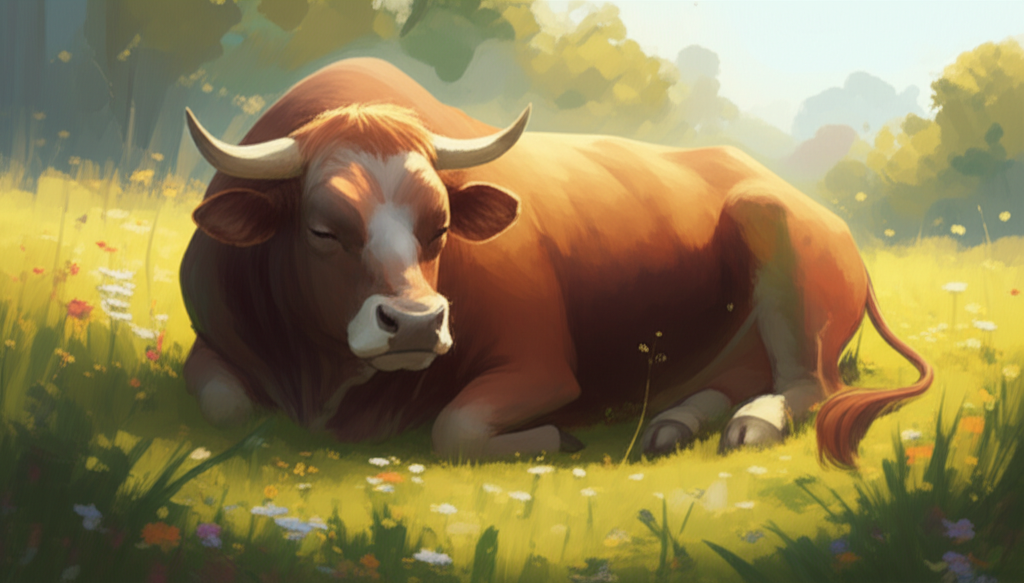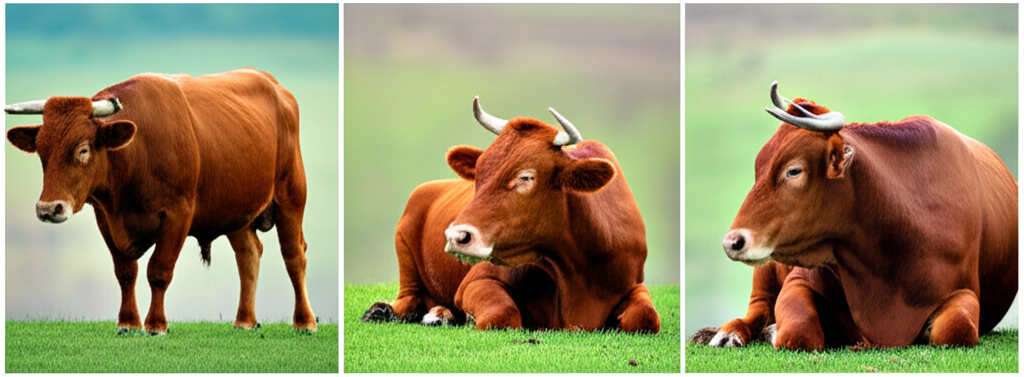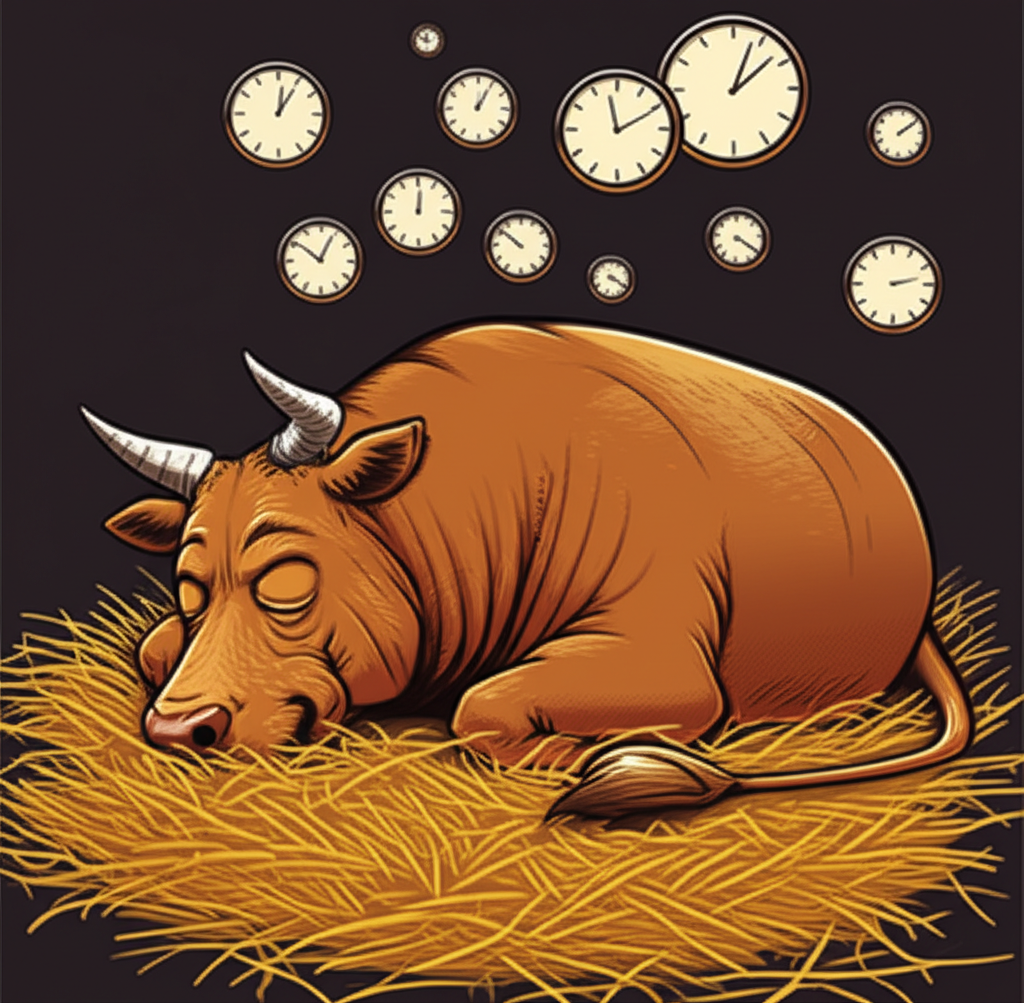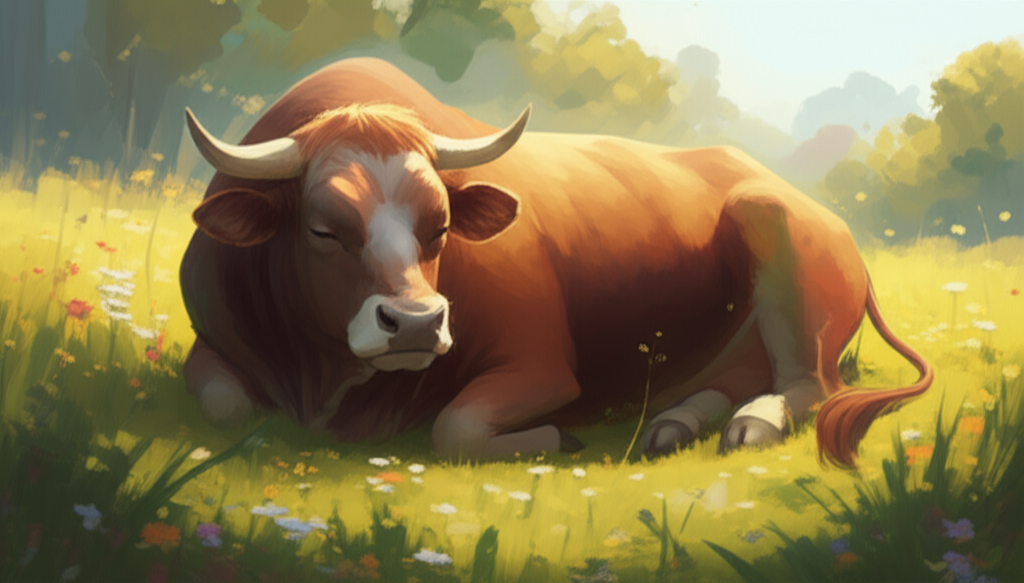Introduction: The Enigmatic Slumber of the Bull

There’s something deeply moving about the image of a bull at rest—its massive frame still, its breath slow and steady beneath the open sky. Often seen as a symbol of unyielding power and raw energy, the bull reveals a quieter side when it sleeps, one that speaks to balance, resilience, and the universal need for rest. This moment of stillness, though fleeting, offers more than just a picturesque scene; it opens a window into the animal’s biology, emotional state, and evolutionary adaptations. While many assume bulls simply stand or graze throughout the day, their sleep behavior is both complex and essential. This article explores how bulls rest, the science behind their sleep cycles, the environmental and social factors that influence their slumber, and the cultural meanings tied to this surprisingly intimate act.
How Do Bulls Sleep? Positions, Patterns, and Physiology

Sleep in bulls isn’t as straightforward as it might appear. It’s not merely about closing their eyes—it’s a carefully balanced act shaped by survival, physiology, and environmental cues. Understanding their rest requires looking beyond surface-level observation to examine the rhythms, positions, and biological imperatives that define their downtime.
The Science of Bull Sleep: Duration and Cycles
Like all mammals, bulls rely on sleep to support brain function, tissue repair, and immune health. However, their sleep is markedly different from that of humans or even domestic pets. On average, an adult bull sleeps for just **3 to 4 hours per day**, with this time distributed in short intervals rather than one continuous stretch. This fragmented pattern reflects their evolutionary background as prey animals—creatures that must remain alert to danger even while resting.
Most of their sleep consists of non-REM (non-rapid eye movement) stages, which allow for physical recovery without full unconsciousness. True REM sleep—the phase associated with dreaming and deep cognitive processing—occurs only occasionally and primarily when the bull is lying down in a secure environment. Research indicates that cattle, including bulls, spend much of their resting time in a drowsy, semi-awake state, often with eyes partially open or ears twitching at distant sounds. A study published in the PMC database found that bovine sleep is highly influenced by external rhythms such as feeding times, milking schedules, and social interactions within the herd.
Common Sleeping Positions and Their Meanings
Bulls adopt distinct postures depending on their level of alertness, comfort, and perceived safety. These positions aren’t random—they reflect a nuanced interplay between relaxation and readiness.
- Lying Down with Legs Curled: This is the most typical posture for light to moderate sleep. The bull folds its legs beneath its body, tucking its head close to its flank or resting it on the ground. This compact position allows for muscle relaxation while still enabling a quick rise if needed. It’s commonly seen during midday rest periods in quiet pastures.
- Sternal Recumbency (Upright with Head Resting): In this stance, the bull lies on its chest with front legs folded and hind legs tucked under. The head rests on the ground or on its forequarters. While it may appear asleep, this is usually a state of light rest where the animal remains partially alert. It’s a transitional position, often used between grazing and deeper rest.
- Lateral Recumbency (Lying on Side): When a bull lies fully on its side with legs stretched out, it signals deep relaxation. This posture allows for full muscle release and is the only position in which REM sleep is likely to occur. It’s typically observed in safe, familiar environments and indicates a high level of trust in the surroundings.
Do Bulls Sleep Standing Up? Dispelling Myths

A widespread belief suggests that bulls can sleep standing up. The truth is more nuanced. While bulls can—and often do—rest while standing, they do not experience deep, restorative sleep in this position. Their ability to remain upright for long periods comes from a specialized anatomical feature known as the “stay apparatus,” a system of ligaments and tendons that locks the knee and stifle joints, allowing them to relax their muscles without collapsing.
This adaptation enables them to doze lightly while staying ready to react instantly to threats. However, because REM sleep requires full muscle atonia—essentially temporary paralysis to prevent acting out dreams—standing sleep cannot support this phase. For real, restorative rest, bulls must lie down. A bull standing motionless with closed eyes is likely in a light doze, not in a state of deep slumber.
The Importance of Sleep for Bull Health and Behavior

Sleep is far from a passive state for bulls—it’s a critical component of their physical health, mental stability, and social functioning. Depriving a bull of quality rest can have cascading effects on its well-being, productivity, and temperament.
Why Sleep is Crucial: Physical and Mental Benefits
During sleep, the bull’s body engages in vital maintenance tasks: repairing muscle tissue damaged during movement or mating, synthesizing proteins, regulating hormones, and strengthening immune defenses. These processes are especially important for bulls used in breeding, where physical demands are high. Inadequate rest can lead to slower recovery, reduced fertility, and increased susceptibility to infections.
Mentally, sleep helps consolidate experiences and manage stress. A well-rested bull tends to be calmer, more responsive to handling, and less prone to sudden aggression. Conversely, sleep-deprived bulls may exhibit irritability, hyper-vigilance, or unpredictable behavior—traits that pose risks in both farm and ranch settings.
Environmental Factors Affecting Bull Sleep
Even with biological needs dictating rest, a bull’s environment plays a decisive role in whether it can actually achieve restful sleep.
- Habitat: Soft, dry bedding such as straw or sand encourages lying down. Hard, wet, or muddy surfaces discourage recumbency, limiting opportunities for deep sleep.
- Weather: Extreme temperatures disrupt rest patterns. In intense heat, bulls may stand to increase airflow and reduce body heat; in cold, windy conditions, they may huddle but avoid full relaxation.
- Predation Risk: Even domesticated bulls retain instinctual wariness. In open fields or unfamiliar areas, they may limit deep sleep to moments when they feel safest, often at night or during quiet daylight hours.
- Social Dynamics: Within a herd, dominant individuals often claim the most comfortable resting spots. Subordinate animals may remain partially alert, reducing their sleep quality. A stable, harmonious group structure promotes better rest for all members.
Bulls in Dreamland: Comparing Bovine Sleep to Other Animals
Sleep strategies across the animal kingdom vary dramatically based on diet, size, predation risk, and metabolic needs. Placing the bull’s sleep habits in this broader context reveals how finely tuned their patterns are to their ecological role.
Bull Sleep vs. Other Domestic Animals (Cows, Horses, Dogs)
Bulls and cows, being the same species (*Bos taurus*), share nearly identical sleep requirements. However, bulls may exhibit slightly different behaviors due to hormonal influences and social roles, particularly in breeding seasons. Cows with calves or those in lactation may rest more frequently due to energy demands.
Horses, like bulls, are large herbivores and prey animals. They also use the stay apparatus to rest standing and require short bursts of REM sleep—about 2 to 3 hours daily—achieved only when lying down. But unlike cattle, horses are more prone to “sleep attacks” if chronically sleep-deprived, a condition rarely seen in bulls.
Dogs, as carnivores and social predators, have vastly different needs. They sleep 12 to 14 hours a day, with frequent REM cycles, often dreaming vividly. Their deep sleep occurs in curled or stretched positions, usually in enclosed, secure spaces like dens or crates.
| Animal | Average Daily Sleep (Hours) | Can Rest Standing Up? | Dominant Sleep Position for Deep Sleep |
| :——— | :————————– | :——————– | :————————————- |
| Bull/Cow | 3-4 | Yes | Lying down (sternal or lateral) |
| Horse | 2.5-3 (deep sleep) + resting | Yes | Lying down (sternal or lateral) |
| Dog | 12-14 | No | Lying down (curled, stretched) |
Unique Sleepers: Fascinating Facts from the Animal Kingdom
The animal world is full of extraordinary sleep adaptations. For example, certain species of snails can enter estivation—a dormant state lasting up to **three years**—to survive drought and extreme heat. Meanwhile, koalas sleep up to **20 hours a day**, a necessity driven by their low-nutrient eucalyptus diet, which slows their metabolism to a crawl.
In contrast, the bull’s modest sleep quota reflects its status as a large, herbivorous prey animal. It doesn’t need prolonged rest like a predator recovering from intense hunts, nor does it face the metabolic constraints of a specialist feeder. Instead, its sleep pattern strikes a balance between energy conservation and constant environmental awareness.
The Symbolism and Cultural Significance of a Sleeping Bull
Beyond biology, the image of a sleeping bull resonates across cultures and mythologies, often representing deeper truths about power, peace, and the cycles of nature.
Sleeping Bull Meaning
A bull at rest carries layered symbolism, embodying contrasts that have fascinated humans for centuries.
- Peace and Tranquility: In agrarian societies, a sleeping bull often symbolizes a time of abundance and harmony. Its rest implies fertile land, skilled stewardship, and a balanced ecosystem.
- Latent Power: The stillness of a powerful animal suggests not weakness, but restrained strength. The sleeping bull becomes a metaphor for potential energy—calm now, but capable of immense action when needed.
- Vulnerability: In lying down, the bull exposes its underbelly, the most unprotected part of its body. This moment of openness signifies trust, safety, and the necessity of rest even for the strongest.
- Spiritual and Mythological Contexts: In ancient Mesopotamian, Minoan, and Hindu traditions, bulls were sacred symbols of fertility, virility, and divine power. A resting bull could represent a deity in meditation or a guardian spirit conserving energy. In dream interpretation, seeing a sleeping bull might signal a period of inner calm before a major life shift or a call to harness one’s own inner strength wisely.
Though there’s no formal term specifically for a sleeping bull—unlike “calf” or “heifer”—phrases like “the slumbering giant” or “the peaceful behemoth” are often used in literature and art to evoke its quiet dignity.
Conclusion: Appreciating the Resting Giant
The sight of a bull asleep is more than a moment of serenity—it’s a window into the intricate balance between strength and vulnerability, alertness and rest. From the fragmented 3- to 4-hour sleep cycle to the deliberate choice of posture, every aspect of a bull’s slumber reflects millions of years of adaptation. These patterns ensure survival, support health, and reveal the animal’s deep connection to its environment and social group.
Understanding how bulls sleep not only deepens our appreciation for their biology but also informs better animal husbandry practices. Providing safe, comfortable spaces for rest isn’t just a matter of comfort—it’s essential for welfare, productivity, and humane treatment. As we observe these powerful creatures in their quietest moments, we’re reminded that even the mightiest beings need peace to thrive.
How many hours a day does a bull typically sleep?
An adult bull typically sleeps for about 3 to 4 hours per day in total, often broken into several short bouts throughout a 24-hour period. This cumulative sleep combines both light and deep sleep stages.
Do bulls sleep standing up, or do they primarily lie down?
Bulls can rest and doze while standing, utilizing a “stay apparatus” in their legs. However, for true, deep, and restorative sleep, especially REM sleep, they must lie down. Lying down allows for complete muscle relaxation essential for these deeper sleep stages.
What are the key differences between a bull’s deep sleep and light resting periods?
During light resting periods, a bull might be standing or in sternal recumbency (lying on its chest) and can quickly react to disturbances. It’s often in a drowsy, non-REM state. Deep sleep, particularly REM sleep, occurs when the bull is fully lying on its side (lateral recumbency), allowing for complete muscle relaxation and reduced responsiveness. It’s during deep sleep that essential physiological and cognitive restoration takes place.
Is there any symbolic or cultural meaning associated with a sleeping bull?
Yes, a sleeping bull often symbolizes peace, tranquility, and latent power – immense strength at rest. It can also represent vulnerability or a period of calm before significant events. In various cultures, it might signify prosperity, a well-tended environment, or even a divine entity in repose. Bulls have been revered in many ancient civilizations for their strength and fertility, and their resting state can carry these deeper implications.
How does a bull’s sleep pattern compare to that of other large mammals?
Bulls, like other large prey animals such as horses, have relatively short and fragmented sleep patterns compared to predators like dogs or humans. They prioritize vigilance, often resting in short bursts and achieving deep sleep only when they feel secure. Their total sleep duration is significantly less than that of many other mammals.
What environmental factors can influence a bull’s sleep quality and duration?
Several environmental factors impact bull sleep, including:
- Comfortable Bedding: Dry, soft surfaces encourage lying down.
- Temperature: Extreme heat or cold can disrupt rest.
- Security: Perceived safety from threats allows for deeper sleep.
- Noise and Disturbances: Loud noises or frequent interruptions can prevent sustained rest.
- Social Dynamics: Hierarchy and herd security can influence individual sleep opportunities.
Can a sleeping bull still be aware of its surroundings or potential threats?
During light resting periods or even light NREM sleep, a bull can remain somewhat aware of its surroundings and react quickly to potential threats. However, during deep REM sleep (when lying fully on its side), its awareness is significantly reduced, making it more vulnerable and less responsive to external stimuli.
Are there specific terms or names for a bull when it is asleep or resting?
While there isn’t a unique formal term for a sleeping bull, people often use descriptive phrases like “a resting bull,” “a slumbering giant,” or “a peaceful behemoth” to refer to it. In scientific contexts, it would simply be referred to as “a bull in a state of sleep or rest.”
Why is adequate sleep essential for a bull’s overall health and well-being?
Adequate sleep is crucial for a bull’s health because it facilitates physical recovery, aids in digestion, strengthens the immune system, and supports cognitive functions. Sufficient rest also contributes to a calmer temperament, reduced stress, and overall better physical condition, which is vital for animal welfare.
Do young calves sleep more or less than mature bulls?
Generally, young calves sleep significantly more than mature bulls. Like most young mammals, calves require more sleep for growth, development, and brain maturation. They spend a larger proportion of their day resting and sleeping, often in deep, undisturbed slumber, as their mothers or herd provide protection.

留言